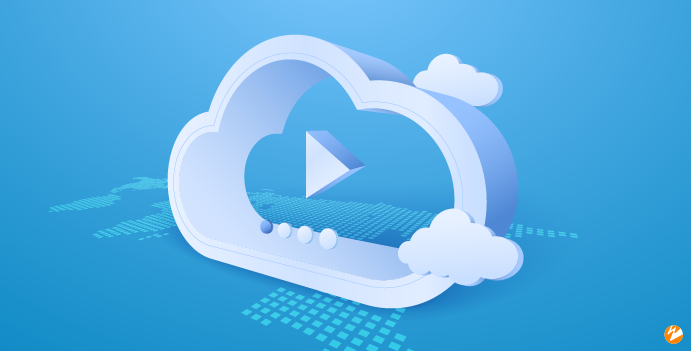In the current digital era, when everything is available online, cloud video streaming and cloud streaming platforms have fundamentally altered the way we view media at home. Cloud streaming enables high-quality video delivery at a far lower cost than traditional methods.
We will go over what cloud video streaming is in this blog post, along with some of the main advantages of cloud streaming services.
What is Cloud video streaming?
Users may watch digital video material online without downloading it by using cloud video streaming. Real-time content delivery and a reliable internet connection are used to achieve this.
Streaming entertainment gains popularity as the need for internet material rises. Therefore, a dependable and expandable solution is needed. Companies may upload videos to the cloud and distribute them to a larger audience by using cloud video streaming. Through encryption, CDN problems, encrypted video streaming, and other means, they may ensure perfect playback, expedite the delivery of media, and save money.
Key Components of Cloud Video Streaming
Content Delivery Network (CDN):
A worldwide network of servers is similar to a content delivery network, or CDN. It helps in the global distribution of videos across various servers. This is important since it guarantees that, no matter where you are, you can easily and swiftly access videos for viewing. CDNs store copies of videos in several places, which helps to minimize buffering and loading times. Therefore, the video may originate from a nearby server, which is considerably quicker, rather than needing to travel from a distant server to your device.
video may originate from a nearby server, which is considerably quicker, rather than needing to travel from a distant server to your device.
Encoding and Transcoding:
Videos are encoded and transcoded in order to prepare them for online streaming. Unprocessed video data is converted into digital representations suitable for internet streaming through the encoding process. However, transcoding means creating separate copies of these video files with different bitrates and resolutions. This is important since different devices and internet speeds require different video formats.
Video Players and Streaming Protocols:
Video players are the applications or devices we use on our PCs, tablets, and smartphones to view streaming videos. Streaming protocols are the set of guidelines that regulate how videos are delivered to and decoded by these players. These procedures take care of network disruptions, quality adjustments, and buffering to assist ensure that movies play smoothly on our devices. They make sure that no matter what gadget we’re using or how strong our internet connection is, we can view movies without any issues.
Benefits of Cloud Video Streaming
Let’s look at how cloud video streaming makes it easier to handle a lot of content so that it delivers smoothly. Here are some reasons for quickening your success with streaming:
Cost-Friendly
Investment is only necessary in areas that are directly connected to bandwidth and storage requirements. Examining cloud based live streaming options makes cost management easier rather than requiring a substantial upfront expenditure.
Because cloud video streaming services do not require large upfront infrastructure expenditures, they are inexpensive. Businesses can choose for pay-as-you-go, which enables them to only pay for the resources they really use. This economical approach suggests that businesses should scale up their video streaming operations to meet demand in order to avoid spending for wasted bandwidth. Cloud based video streaming services usually provide low-cost pricing options as well as volume use discounts to boost their affordability.
Global Reach
With a reliable internet connection, the target audience may easily view video material from any place. Whether at work or on the road, these platforms provide simple access to videos.
Cloud video streaming systems are easily scalable, allowing several users to use them at the same time from different locations. This means that content creators can communicate with a global audience without being constrained by bandwidth or infrastructure issues. Content delivery networks (CDNs) reduce latency and provide viewers with a consistent viewing experience everywhere by keeping cached copies of material in many data centers throughout the world.
Unlimited Storage Capacities
Live streaming services provide an economical way to store an infinite amount of data. Data storage is made almost infinite by additional storage options like bulk uploading, content scheduling, and archived assets. Businesses can scale to meet the increasing demand for video content by storing enormous amounts of information without worrying about running out of capacity thanks to endless storage. For companies looking to grow their video libraries without being constrained by physical storage requirements, this scalability is crucial.
Furthermore, by saving businesses from investing in costly computer infrastructure, the cloud’s endless storage capacity lowers upfront expenses and offers a more affordable option. Additionally, having unlimited storage ensures that viewers will always have access to and enjoyment from video content, which enhances the user experience overall. Moreover, it enables the implementation of strong redundancy and backup strategies, guaranteeing the safe storage of video files and preventing data loss.
Conclusion
Video streaming cloud service has transformed how we watch videos online, making it more convenient and enjoyable for everybody. It has grown into a vital resource for businesses and artists, and it will only become better from here on out. There are several advantages of a cloud streaming platform, and its ability to transform how we work and use technology cannot be overstated. Cloud streaming platforms will undoubtedly have a bigger influence on how technology develops and how people interact in the future as the world grows more digital and networked.
